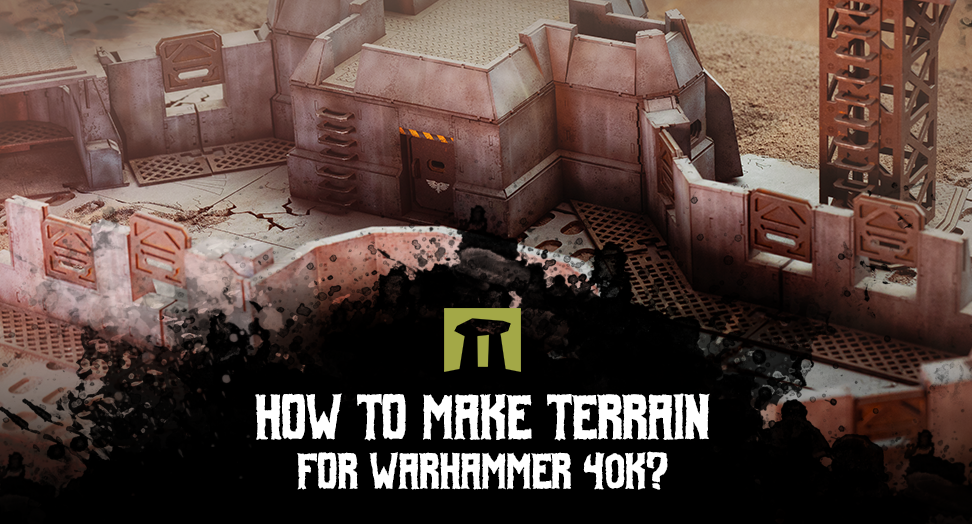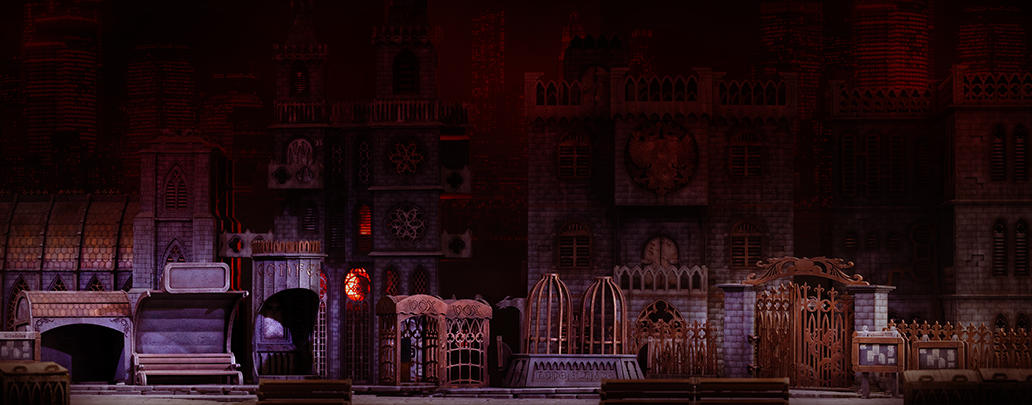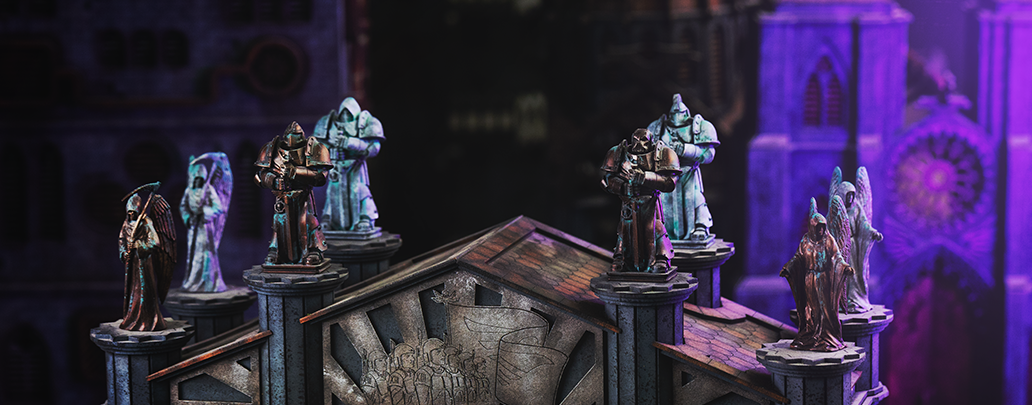How to make terrain for Warhammer 40k?

So this is it - you finally finished your Warhammer 40k army. It’s fully assembled and painted. You’re proud of what you’ve accomplished, and now - as the troops are more than ready to battle any opponent - you wish to deploy that mighty force. But then there comes an issue. After all, you don’t want to place your army on a flat table. It doesn’t seem like a suitable area for such excellent prepared soldiers. You begin to wonder, and you get the correct answer in a minute - you need some equally finished terrain for them!
If that’s - more or less - what happened to you, stay calm. You’re in the right place. Sit comfortably, take a deep breath and let us list our thoughts and advice on how to make terrain for (not only an army but in general) Warhammer 40k. Worry not - we can assure you that creating (or gathering) wargaming terrain could be much fun. It isn’t difficult either - it doesn’t require any unimaginable skills.
Choose a good location for your terrain
That first statement above can sound a little enigmatic, we confess. But it isn’t a riddle that if you want to play wargames, you’ll need some terrain - it doesn’t matter if professionally looking or provisory. And to gather some terrain, you should possess a vast, clean area. That’s what we mean when talking about the “location.”

Building something as enormous as the whole Hive City isn’t necessary to play, but it indeed is impressive
The location for your terrain needs to be flat and pretty big. It’s always a good thing to remember that it should also be somewhere where it doesn’t bother anyone - so you’ll have absolute peace and quiet when you use that space (it means: when you’ll play on the created battlefield full of terrain).
When looking for a good location, you’ll conclude that a tabletop is a natural choice. But be careful - on the other hand, the top of an average table might not be enough for your needs. It would be best if you placed the terrain on a space that matches the dimensions listed in the rules of the specific wargame you wish to play (for instance, Warhammer 40k). So before anything else, ensure you know precisely how you would like to use both your rising terrain and soon-to-be battlefield.
Collect materials to use for building your terrain
You can peacefully proceed to the next step once you know where to place your battlefield and how to decorate it with suitable scenery. And that step is to gather the supplies.
To do so, look not only for all the things you know you’ll need but also for what you might need - including cardboard, rocks, etc. What’s more, that’s the moment when it’s good to decide whether you prefer to focus on making 3D or 2D terrain. Why now? The answer is simple - to know more precisely what materials you’ll need so that you won’t collect something useless.
When gathering the supplies, please take a look at our offer. At Kromlech, we have a fair range of modeling and basing products. There is static grass, basing sand, clump foliage, cork sheets, and plasticard - plenty of hobby materials perfect for creating almost every kind of scenery. What’s more, if you need the standard tools used in most converting processes - such as glues, hobby knives, or even hobby chains - worry not. You’ll also find all of them there!
Plan out the design of your terrain
Planning out the design of your terrain shouldn’t be a challenging task. You need to know what kind of scenery you would like to portray on your battlefield. The possibilities are numerous - you can go with jungle terrain, desert, ice world, forest, city, and many more. And if you’re not a fan of such choices, let us give you some advice. If you already have a finished, fully-painted army, look at the bases of your troops. If you did them in one specific style, making a battlefield with the same (or similar) appearance might be a good idea.

You don’t necessarily need to stick to the known, well-developed themes when making terrain. Building an entire planetary base on an unknown moon can be much more fun and satisfying than making a strict forest
Remember that you can always mix some themes - it’s up to you. The battlefield you’re creating can be assembled from terrain representing different biomes. After all, the galaxy of Warhammer 40k is long and wide - we’re sure that there you could find almost every ecosystem you can imagine.
And speaking about diversity, it’s good to remember that you aren’t limited to only the handmade pieces of terrain. Although making something from the beginning can be challenging and satisfying, it isn’t the only way. If you wish to add some pre-designed terrain pieces to your handmade stuff, browse our Tabletop Scenics catalog. An enormous cafeteria of HDF scenery awaits you there. And don’t be tricked - it isn’t some “easy way out.” The sets you can get there require assembly and painting, so it could still be a fun challenge. And the cherry on the top - the prices aren’t high, so deciding to go this way, you can still make your terrain cheap.
Assemble the pieces of your terrain
Assembling is undoubtedly the least fascinating part of creating the terrain. Nonetheless, it’s probably the most vital one at the same time. The best way to assemble almost any model in the world of wargaming is by using super glue. Besides the usual safety measures (which we highly recommend incorporating into your assembling process), you’ll need to watch out not to overuse the glue. The components must stick together, that’s right - but sometimes it’s good to wait a minute or two, allowing the science to do its work. Let’s try this before we test the durability of our new construction, make a statement that “none can glue that thing!” or proceed to the next step, which involves more gluing on this specific piece of terrain.
As we stated earlier, if you’re looking for a good glue for your models, take a look at our modeling and basing offer.
Paint and decorate your terrain
Painting your rising terrain is highly dependable on what design you previously chose. For example, it’s completely natural that you’ll need much more white paint when you go into some winter themes. Adding the finishing touches to your new terrain is a little bit more tricky. You don’t have to, but because it can make a difference, why don’t you try it?
The possibilities of decorating your terrain are never-ending, especially when making a multi-biome battlefield. However, there are some universal solutions, and weathering powders seems like one of them. If you want to make your terrain more “alive” and realistic, consider using our weathering powders during the final step of creating your landscape.
Additionally, nothing makes the scenery more interesting than a handful of bits. Whether these are abandoned guns, skulls of long-forgotten enemies, or remnants of ancient civilization, it’s always a great idea to “upgrade” the terrain with such details. Thanks to our Kromlech 3D Workshop category, you can afford all these types of bits in a digital form and print them in desired quantity whenever you need.
Play with your new Warhammer 40k terrain!
After all this work, the time will come when you’re able to play. Play not only with your fully-prepared army but also on a beautifully done battlefield full of unique terrain features. As always, there is still something you can do to improve your reception of the game. Although it might seem like you finally have everything you need, if you still feel something is missing, stay with us for the rest of this article.

Don’t forget about small but impactful details such as the statues on the top of the roofs - in truly grim dark future clime
What might be lacking are probably gaming accessories. That’s right - it can be the final piece of the puzzle which is playing Warhammer 40k on a truly professional level. It’s good to underline that not everyone has to try to achieve that, but if someone wants to, here we are. To help in this uneasy process.
The things that everyone usually remembers are the dice. More precisely, battle dice. Even if these are pretty easy to find, getting the desired, matching-your-army color might be problematic and frustrating. That’s why we’ve gathered in our webstore some traditionally-looking sets of dice in different colors, matching most of the regular wargaming armies.
But suitable dice aren’t the only thing that adds much to your game when present on the table. Even more eye-catching are tokens, markers, templates, and similar accessories. If you’re tired of using coins and buttons that ruin the whole immersion, try some of our plexi tokens. Some look like they’re literal holographic projections of objectives and vital positions marked on the battlefield.
And - last but not least - proper dessert. Battle rulers. They’re not only good-looking (similar to the tokens we wrote about in the previous paragraph), but also unbelievably handful. Especially if your battlefield is full of painted terrain that you wouldn’t like to devastate with a primary measurement tool. Remember - such a battle ruler could be a fantastic addition not only to your finished scenery but to the game overall!
Finally, the time has come for the last piece of advice. No matter if your terrain is handmade, bought, provisory, or professionally looking, always remember to enjoy your game! After all, what matters the most is having fun playing Warhammer 40k or any other wargame.




